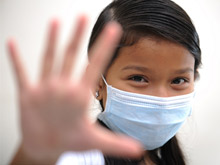Health Topics
-
Healthy Living
-
|
|
December 2009
|
| H1N1 Work in Progress |
| Dr Seemanthini Desai |
| |
 |
Community strategies (also called non-pharma-ceutical interventions) that delay or reduce the impact of a pandemic may help reduce the spread of disease until a vaccine is available The US Occupational Safety and Health administration (OSHA) and the Center for Disease Control and Prevention (CDC) have developed guidelines, |
| including checklists, to assist businesses, industries, and other employers in planning for a pandemic outbreak as well as for other comparable catastrophes. |
4 Guidelines for Employers
Employers can use a set of occupational safety and health controls to reduce exposures to pandemic influenza in their workplaces.
- Engineering controls: Making changes to the work environment to reduce work-related hazards, like installing physical barriers, such as clear plastic sneeze guards, installing a drive-through window for customer service.
- Administrative controls: Modify employees' work schedules and tasks in ways that minimise their exposure to workplace hazards. Develop policies that encourage ill workers to stay at home without fear of any reprisals – that would be better than having the bugs infect the whole place. You could also develop practices to minimise face-to-face contact between workers such as extended use of e-mail, websites and teleconferences.
- Work practices: Reduce the duration, frequency or intensity of exposure to this hazard by providing employees with up-to-date education and training on influenza risk factors, protective behaviours, and instruction on proper behaviours (for example, cough etiquette; avoiding touching eyes, nose and mouth). You can also promote a work environment that promotes personal hygiene. For example, provide tissues, no-touch trash cans, hand soap, hand sanitizer, disinfectants and disposable towels for workers to clean their work surfaces.
- Personal Protective Equipment (PPE): Better be safe than sorry. If it comes to protective gear (respirators like N95), face shields, goggles and disposable gloves to keep works safe, then so be it.
While engineering and administrative controls and proper work practices are considered to be more effective in minimising exposure to the influenza virus, the use of PPE may also be called for, during certain exposure situations and during emergencies.
|
13 Guidelines for Employees
The best strategy to reduce risk of becoming ill with pandemic influenza is to avoid crowded settings and other situations that increase the risk of exposure to someone who may be infected. If you must be in a crowded setting, minimise your time there. Some basic hygiene and social distancing precautions that can be used in every workplace include:
- Stay home if you are sick.
- Wash your hands frequently with soap and water for 20 seconds or with a hand sanitiser if soap and water are not available.
- Avoid touching your nose, mouth and eyes.
- Cover your coughs and sneezes with a tissue, or cough and sneeze into your upper sleeve. Dispose off tissues in no-touch trash receptacles.
- Wash your hands or use a hand sanitiser after coughing, sneezing, or blowing your nose.
- Avoid close contact (within 6 feet) with co-workers and customers.
- Avoid shaking hands (till the bug passes) and always wash your hands after physical contact with others.
- If wearing gloves, always wash your hands after removing them.
- Keep frequently touched common surfaces (telephones, computer equipment, etc.) clean.
- Try not to use your colleagues' phones, desks, offices, or other work tools and equipment.
- Minimise group meetings for some time: use e-mails, phones and text messaging. If meetings are unavoidable, avoid close contact (within 6 feet) with others and ensure that the meeting room is properly ventilated.
- Limit unnecessary visitors to the workplace.
- Maintain a healthy lifestyle: attention to rest, diet, exercise and relaxation helps maintain physical and emotional health.
|
|
 |
Dr. Seemanthini Desai is Consultant Microbiologist at Apollo Hospitals, Bangalore |
|
|